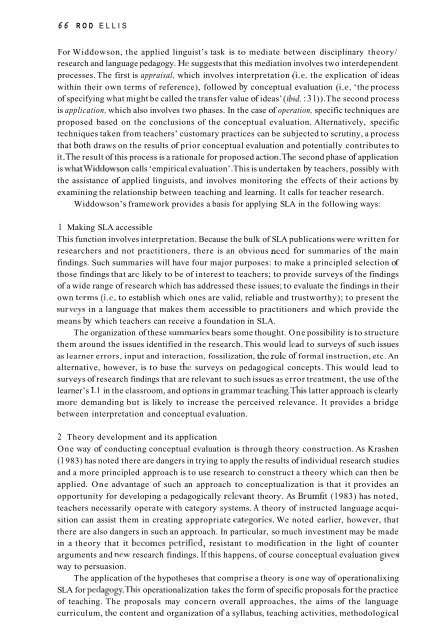English Language Teaching in its Social Context
English Language Teaching in its Social Context
English Language Teaching in its Social Context
You also want an ePaper? Increase the reach of your titles
YUMPU automatically turns print PDFs into web optimized ePapers that Google loves.
66 ROD ELLISFor Widdowson, the applied l<strong>in</strong>guist’s task is to mediate between discipl<strong>in</strong>ary theory/research and language pedagogy. He suggests that this mediation <strong>in</strong>volves two <strong>in</strong>terdependentprocesses. The first is appraisal, which <strong>in</strong>volves <strong>in</strong>terpretation (i.e. the explication of ideaswith<strong>in</strong> their own terms of reference), followed by conceptual evaluation (i.e. ‘the processof specify<strong>in</strong>g what might be called the transfer value of ideas’ (ibid. : 3 1 )).The second processis application, which also <strong>in</strong>volves two phases. In the case of operation, specific techniques areproposed based on the conclusions of the conceptual evaluation. Alternatively, specifictechniques taken from teachers’ customary practices can be subjected to scrut<strong>in</strong>y, a processthat both draws on the results of prior conceptual evaluation and potentially contributes toit.The result of this process is a rationale for proposed action.The second phase of applicationis whatwiddowson calls ‘empirical evaluation’ .This is undertaken by teachers, possibly withthe assistance of applied l<strong>in</strong>guists, and <strong>in</strong>volves monitor<strong>in</strong>g the effects of their actions byexam<strong>in</strong><strong>in</strong>g the relationship between teach<strong>in</strong>g and learn<strong>in</strong>g. It calls for teacher research.Widdowson’s framework provides a basis for apply<strong>in</strong>g SLA <strong>in</strong> the follow<strong>in</strong>g ways:1 Mak<strong>in</strong>g SLA accessibleThis function <strong>in</strong>volves <strong>in</strong>terpretation. Because the bulk of SLA publications were written forresearchers and not practitioners, there is an obvious need for summaries of the ma<strong>in</strong>f<strong>in</strong>d<strong>in</strong>gs. Such summaries will have four major purposes: to make a pr<strong>in</strong>cipled selection ofthose f<strong>in</strong>d<strong>in</strong>gs that arc likely to be of <strong>in</strong>terest to teachers; to provide surveys of the f<strong>in</strong>d<strong>in</strong>gsof a wide range of research which has addressed these issues; to evaluate the f<strong>in</strong>d<strong>in</strong>gs <strong>in</strong> theirown terms (i.e. to establish which ones are valid, reliable and trustworthy); to present thesurveys <strong>in</strong> a language that makes them accessible to practitioners and which provide themeans by which teachers can receive a foundation <strong>in</strong> SLA.The organization of these summaries bears some thought. One possibility is to structurethem around the issues identified <strong>in</strong> the research. This would lead to surveys of such issuesas learner errors, <strong>in</strong>put and <strong>in</strong>teraction, fossilization, thc role of formal <strong>in</strong>struction, etc. Analternative, however, is to base the surveys on pedagogical concepts. This would lead tosurveys of research f<strong>in</strong>d<strong>in</strong>gs that are relevant to such issues as error treatment, the use of thelearner’s L1 <strong>in</strong> the classroom, and options <strong>in</strong> grammar tcach<strong>in</strong>g.This latter approach is clearlymore demand<strong>in</strong>g but is likely to <strong>in</strong>crease the perceived relevance. It provides a bridgebetween <strong>in</strong>terpretation and conceptual evaluation.2 Theory development and <strong>its</strong> applicationOne way of conduct<strong>in</strong>g conceptual evaluation is through theory construction. As Krashen(1 983) has noted there are dangers <strong>in</strong> try<strong>in</strong>g to apply the results of <strong>in</strong>dividual research studiesand a more pr<strong>in</strong>cipled approach is to use research to construct a theory which can then beapplied. One advantage of such an approach to conceptualization is that it provides anopportunity for develop<strong>in</strong>g a pedagogically relevant theory. As Brumfit (1 983) has noted,teachers necessarily operate with category systems. A theory of <strong>in</strong>structed language acquisitioncan assist them <strong>in</strong> creat<strong>in</strong>g appropriate categories. We noted earlier, however, thatthere are also dangers <strong>in</strong> such an approach. In particular, so much <strong>in</strong>vestment may be made<strong>in</strong> a theory that it becomes petrified, resistant to modification <strong>in</strong> the light of counterarguments and new research f<strong>in</strong>d<strong>in</strong>gs. If this happens, of course conceptual evaluation givesway to persuasion.The application of the hypotheses that comprise a theory is one way of operationalix<strong>in</strong>gSLA for pedagogy.This operationalization takes the form of specific proposals for the practiceof teach<strong>in</strong>g. The proposals may concern overall approaches, the aims of the languagecurriculum, the content and organization of a syllabus, teach<strong>in</strong>g activities, methodological












